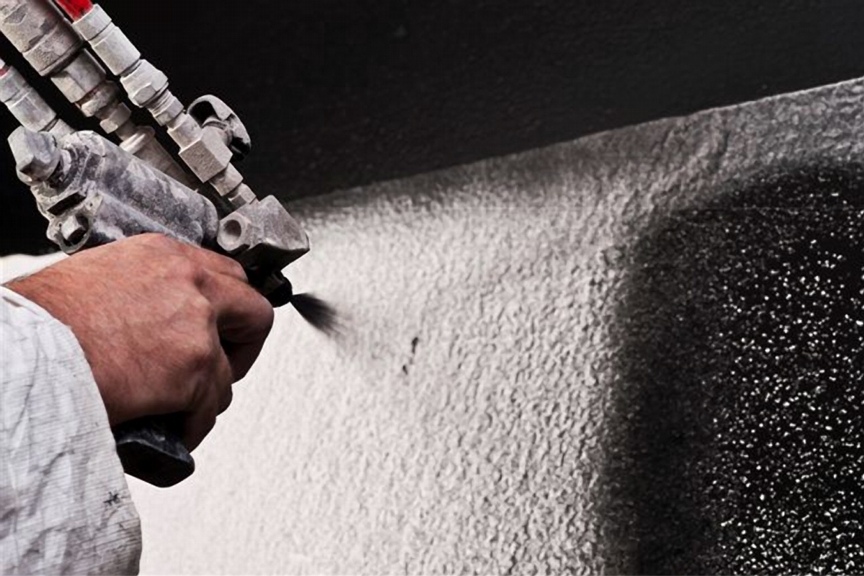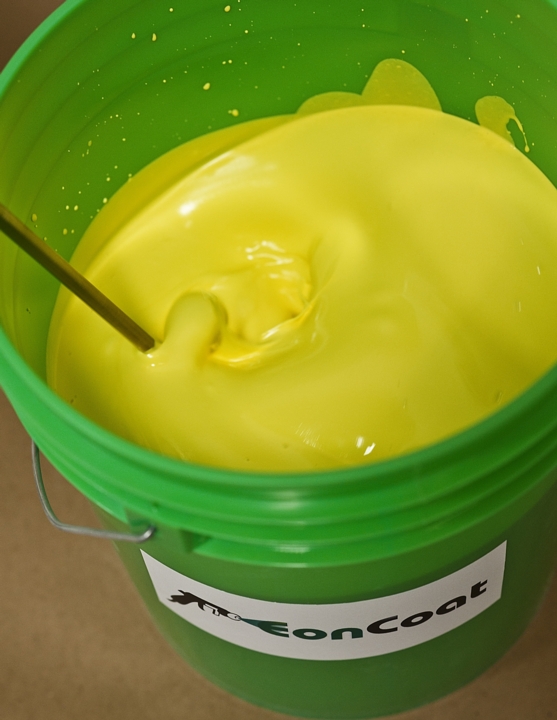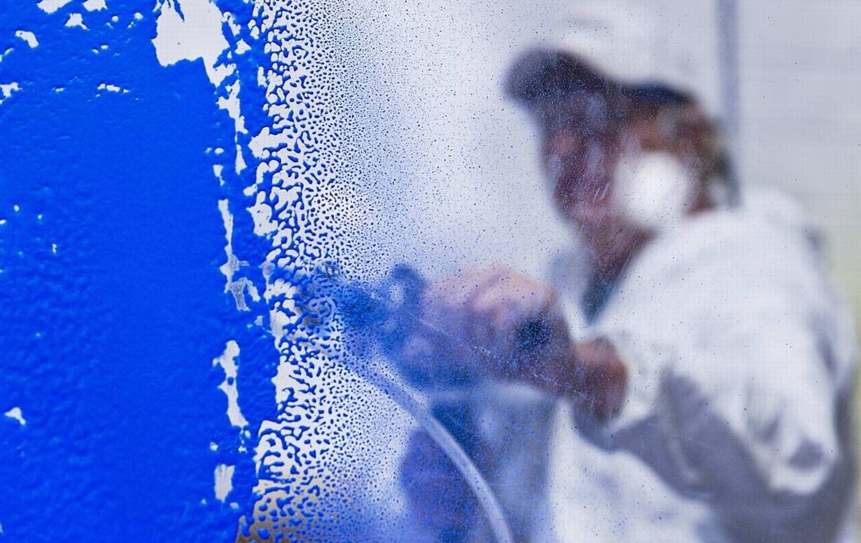Blog Post
EonCoat – A Breakthrough Two-Part Corrosion-Resistant Ceramic Paint

The North Carolina company EonCoat, LLC, has just introduced a corrosion-resistant coating that appears to be a breakthrough product that could revolutionize the painting industry--and not just for specialty applications like corrosion control. (Don't mix this up with ceramic paints that are being promoted for questionable insulating benefits.) EonCoat and EonCoat HT (for High Temperature) are water-borne, two-part, ceramic coatings that set almost immediately to form dense, protective barriers on steel, aluminum, interior or exterior masonry, wood, wallboard, and a wide range of other substrates.
The paint dries in minutes, and can produce a wide variety of architectural finishes, including sand plaster, in a wide range of colors. When installed over metal, only light brushing to remove flaked paint is required; the surface does not have to be sanded down to bare metal.
The two-part coating is mixed in the spray valve during installation. The Material Safety Data Sheets (MSDS) show Part A to be phosphoric acid and Part B to be magnesium hydroxide (well-known by the common name "milk of magnesia")--both of which are used in foods or medications and neither of which raises any red flags. According to company CEO, Tony Collins, EonCoat was the culmination of 15 years of research by the Department of Energy at Argonne National Laboratory(initially focused on a coating that would shield radioactive wastes!), plus three years of combined research between EonCoat and Argonne that was directed toward more widely applicable coatings.

Performance properties
The inorganic, ceramic nature of EonCoat gives it some tremendous properties. It has zero flame-spread without requiring any flame retardant. The corrosion resistance is 50 times that of leading corrosion-control paints. It offers excellent chemical resistance to a wide range of chemicals--rated as "excellent" for xylene, phenol, methanol, isopropyl alcohol, 25% salt solution, and 37.5% salt solutions, while only "good" for concentrated sulfuric acid and "poor" for a 50% sodium hydroxide solution.
As for high-temperature use (on steam pipes, machinery, and industrial equipment), EonCoat HT has been tested through hundreds of cycles of 1,000°F (540°C) without signs of degradation or cracking; the coating is stable and the bond strength stays high even above 3,300°F (1,800°C), but it will have minor expansion cracks, according to the company. By comparison, most paints cannot withstand even a few hundred degrees.
SUPPORT INDEPENDENT SUSTAINABILITY REPORTING
BuildingGreen relies on our premium members, not on advertisers. Help make our work possible.
See membership options »The product also benefits from the inherent hardness of ceramic materials. This results in excellent abrasion resistance--a property measured by "Taber machine" testing. In this test, the number of cycles of a standardized abrasive wheel required to wear down the surface by one mil (one thousands of an inch) is recorded. Standard polymer paints are rated at about 75 cycles and epoxy paints 125 to 250 cycles, while EonCoat is rated at 700 cycles and EonCoat HT at 1,150 cycles.
Health and environmental attributes
All these performance properties are pretty cool, but the health and environmental attributes are what first caught my attention.
For starters, EonCoat contains no VOCs and no hazardous air pollutants (HAPs). I reviewed 14 pages of detailed test results from Columbia Analytical Services in Jacksonville, Florida, listing multiple testing methods for dozens of compounds, including acetone, benzene, chlorobenzene, chloroethane, ethylbenzene, styrene, toluene, trichloroethene, vinyl chloride, xylene (and many more with even more syllables). The result for every compound in the report was "not detected."
The EonCoat website quotes EPA Toxic Release Inventory (TRI) data showing that 5.3 million pounds of chemicals are released into the atmosphere annually from paint use: 4 million pounds into the air and another 1.3 million pounds discarded as waste. Those chemical emissions are totally avoided with this product.
The company has examined the carbon dioxide (CO2) emissions associated with manufacture of EonCoat--determining that production of each gallon of paint generates about three pounds of CO2. Most other paints, according to the manufacturer, generate about 30 pounds of CO2 per gallon, so the product has just one-tenth the carbon footprint.
Finally, because the two components of EonCoat are mixed in the spray nozzle, separate mixing pots are not required, so less solid waste is generated.

Cost
The product's cost (about $95/gallon) is higher than that of most other corrosion-control coatings ($37/gallon average), but the avoidance of a primer and a second finish coat save both on materials and labor. An analysis on the company's website shows that the installed cost per square foot is about $1.39 vs. an industry average for corrosion-resistant paints of $2.58. Also, the service life is claimed to be 20 years, vs. 10 for conventional paints.
Compared to standard paint for buildings, though (where corrosion resistance or other specialized performance attributes are not required), EonCoat is more expensive. This will likely slow market penetration into these areas and limit sales primarily to HVAC applications, industrial equipment, machinery, and infrastructure, such as bridges. Assuming it does as well in the field as the manufacturer claims, I expect to see this paint gain significant market share for more conventional building applications.
We'll see how EonCoat does in standard building applications. It was only released for sale to the public this month (January, 2011), though the company has been testing all sorts of substrates for several years. "Customers have expressed interest because of the performance and the beauty," Collins told me. "Contractors are interested because the labor cost is cut in half," he said. He added that both customers and contractors like the fact that the equipment or space can be put back into service after just one day.
For more information:
EonCoat, LLC
Wilson, North Carolina
252-360-3110
See more on this product in the GreenSpec Guide
Alex Wilson is the executive editor of Environmental Building News and founder of BuildingGreen, Inc. In addition to contributing to this product-of-the week blog, he writes the weekly Energy Solutions blog--which this week focused on "drive-by energy audits." To keep up with his latest articles and musings, you can sign up for his Twitter feeds.
Published January 20, 2011 Permalink Citation
(2011, January 20). EonCoat – A Breakthrough Two-Part Corrosion-Resistant Ceramic Paint. Retrieved from https://www.buildinggreen.com/news-article/eoncoat-–-breakthrough-two-part-corrosion-resistant-ceramic-paint



Add new comment
To post a comment, you need to register for a BuildingGreen Basic membership (free) or login to your existing profile.